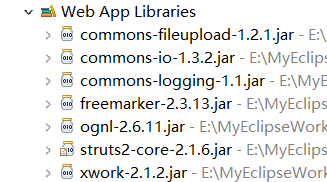1.建立web项目
2.建立Struts2的配置文件(struts.xml)
将Struts2 的空项目 中的配置文件 (struts.xml)复制到项目的 src目录下
struts2.x配置文件的默认存放路径是在/WEB-INF/classes目录下,也就是说,把struts.xml放在src的目录下
1 <?xml version="1.0" encoding="UTF-8" ?> 2 <!DOCTYPE struts PUBLIC 3 "-//Apache Software Foundation//DTD Struts Configuration 2.0//EN" 4 "http://struts.apache.org/dtds/struts-2.0.dtd"> 5 6 <struts> 7 8 <!-- <constant name="struts.enable.DynamicMethodInvocation" value="false" /> 9 <constant name="struts.devMode" value="false" /> 10 11 <include file="example.xml"/> 12 13 14 15 <package name="default" namespace="/" extends="struts-default"> 16 <default-action-ref name="index" /> 17 <action name="index"> 18 <result type="redirectAction"> 19 <param name="actionName">HelloWorld</param> 20 <param name="namespace">/example</param> 21 </result> 22 </action> 23 </package> 24 --> 25 <!-- Add packages here --> 26 <constant name="struts.devMode" value="true" /> 27 <package name="default" namespace="/" extends="struts-default"> 28 <action name="helloy"> 29 <result> 30 hello.jsp 31 </result> 32 </action> 33 </package> 34 35 </struts>
3.复制Struts2相应的jar包及第三方包

4.修改对应的web.xml,建立struts2的filter(参考struts自带的项目)
1 <?xml version="1.0" encoding="UTF-8"?> 2 <web-app version="2.5" 3 xmlns="http://java.sun.com/xml/ns/javaee" 4 xmlns:xsi="http://www.w3.org/2001/XMLSchema-instance" 5 xsi:schemaLocation="http://java.sun.com/xml/ns/javaee 6 http://java.sun.com/xml/ns/javaee/web-app_2_5.xsd"> 7 <welcome-file-list> 8 <welcome-file>index.jsp</welcome-file> 9 </welcome-file-list> 10 11 <filter> 12 <filter-name>struts2</filter-name> 13 <filter-class>org.apache.struts2.dispatcher.ng.filter.StrutsPrepareAndExecuteFilter</filter-class> 14 </filter> 15 16 <filter-mapping> 17 <filter-name>struts2</filter-name> 18 <url-pattern>/*</url-pattern> 19 </filter-mapping> 20 </web-app>
Struts2的访问过程
Struts2的访问过程:
1.客户机发送请求 (http://localhost:8080/struts2/hello.action)
2.请求发送到tomcat,tomcat查看web.xml文件,web.xml里面配置了使用哪个过滤器进行过滤,要过滤哪些请求
3.通过web.xml指导 要使用struts2Filter 这个过滤器,调用这个过滤器,这个过滤器会去参考stuts.xml这个文件
4.struts.xml里面配置了,namespace("/") action("helloy")访问哪个action result("hello.jsp")返回哪个结果 http://localhost:8080/Struts_01/helloy.action
5.filter参考了struts.xml之后,将请求转发到 hello.jsp
6.hello.jsp 返回显示
注:
如果没有编写对应的Action类,不会报错,只要在struts.xml文件中,使用action标签对某个Action进行了注册,
那么会自动执行result为 success 的结果
struts2 为什么要这样做,为什么不直接访问 hello.jsp?
作用: /*将你的请求和展现(视图)分开*/,
每个请求都要经过struts的中转,如果直接访问hello.jsp,那么请求里面就带有了你所需要的展现,如果需要其他的展现,则需要对请求进行修改
而使用struts之后,只需要修改struts.xml这个配置文件就可以了
/*之所以复杂化,是为了可扩展性*/
namespace 决定了action的访问路径,默认为 "" 即 不指定即为 namespace=""
namespace 可以写为/,或者/xxx,或者/xxx/yyy,对应的action访问路径为 /index.action /xxx.index.action /xxx/yyy/index.action
namespace 最好也用模块来进行命令